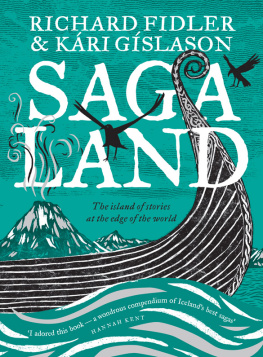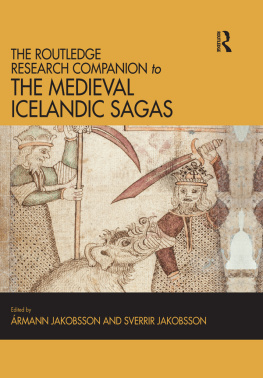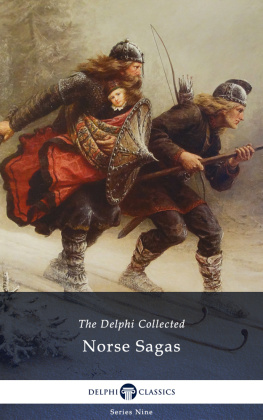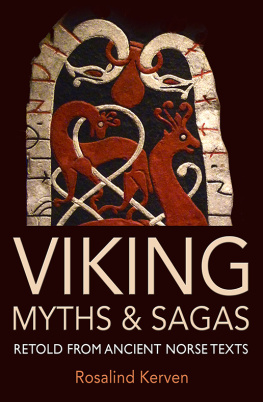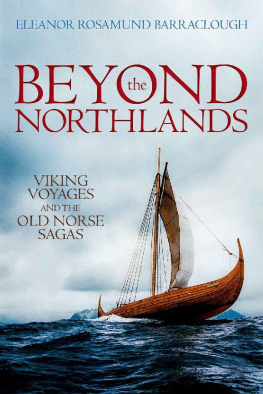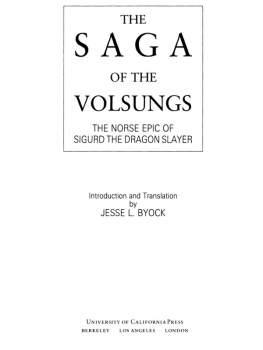I am grateful to everyone who has helped me, directly or indirectly, with this book: family, friends and colleagues (especially Carolyne Larrington and Sin Grnlie, who have provided unstinting practical help and unfailing moral support in the often difficult circumstances of present-day academia), students, and my husband, Bernard. I owe particular thanks to Matthew Roby, who, with his technical expertise, wide knowledge of Old Norse literature and apparently limitless patience, has guided this book from messy script to print. Any remaining messiness is down to me.
Icelandic family sagas the slendingasgur are a unique literary genre. Written in Iceland, for the most part in the thirteenth and fourteenth centuries, they are lengthy prose narratives sometimes interspersed with carefully positioned stanzas of poetry which tell of people and events in Iceland in the period between its settlement in 870 CE and its Christianization, following conversion in the year 1000 CE. Although there is very little in the way of historical or archaeological record with which to compare these sagas, the indications are that at least some of the people and events within them have a basis in historical actuality, while others, and probably most of the dialogue, are invented. Certainly, the society depicted in the family sagas their setting is a plausible recreation of a possible reality. This is largely due to the subject matter of family sagas. Their focus is squarely on human society. Indeed, even when they portray supernatural or otherwise unrealistic phenomena, these tend to be limited to entities of human size and shape such as witches or ghosts rather than the dragons or giants common to other saga genres. Family sagas are very unlike myths or fairy tales. Instead of invention and fantasy, we are presented with a real-feeling world of deceptively familiar human characters in everyday and domestic though often very dramatic circumstances. And in part, this impression of actuality arises from the confident and comprehensive but above all remarkably consistent portrait of early medieval Icelandic society, as if saga authors were working with an authentic and detailed picture of their ancestral society accurately transmitted via oral tradition.
So far, the characteristic literary mode of the family saga might appear very little different from that of the post-medieval historical novel. And indeed family sagas as extended, secular, naturalistic prose narratives have sometimes been compared with nineteenth-century European novels. But what sets apart definitively saga and novel is the distinctive narrative mode of the family saga, and this distinctiveness lies in its authors apparent avoidance of almost all of those literary techniques which Wayne C. Booth termed the rhetoric of fiction. Booth identifies these rhetorical tropes as characteristic of fictional works, especially novels, but it is important to be clear that their use by authors is not confined to or definitively diagnostic of invented, that is, fictional, subject matter. By the same token, the absence of such tropes does not mean that the subject matter of a work is necessarily not invented, however one might define the distinction between history and fiction. The issue is one of narrative style, or mode. So its not just the appearance or possibility of historicity of person and event which defines the family saga, but rather, in the absence of rhetorical tropes characteristic of fictional narrative, a striking historicity or better, non-fictionality of narrative mode. Whether or not the events actually happened, or characters actually existed, they are represented as if they did, or at least might have. So whether family sagas may be regarded or may have been regarded as history or fiction, and indeed what the distinction between the two may be or may have been is not at issue in this book, although it is of course an important question in other contexts and has rightly preoccupied many scholars. Following the French literary theorist and philosopher Paul Ricur in Temps et Rcit (translated into English as Time and Narrative), I see narrativity itself as a bridge between, or interleaving of, history and fiction.
There are two techniques which are central to the rhetoric Booth associates with fictional narratives. One is the establishment of a controlling narrative voice guiding the audiences responses, describing in detail characters inner lives and perhaps even intervening in the narrative with comments based on privileged knowledge of what is happening. The other is the creation of what the Russian formalists termed sjuzhet the order in which events are narrated, or perhaps more simply plot as distinct from fabula the order in which these events, whether fictional or actual, would have taken place if they had happened in a real world, or a simulacrum of one. We might imagine that absence of these two narrative devices would leave us with a narrative akin to historical reportage, in which events are distantly and objectively narrated with no sense of a narrator manipulating for dramatic or emotional effect the order in which they happened, or engaging our sympathy or judgement by giving us privileged access to the minds and hearts of the characters, or intervening in the narrative. But family sagas are very much not detached or minimal narratives. They are rich and detailed, full of psychological subtleties and the vivid dynamics of social and family life; they score very highly on readability and audience engagement.
I shall be looking at ways in which saga authors, even though employing a self-effacing narrative voice, nevertheless maintain the urgency and complexity essentially, the readability of an emotionally engaging fictional narrative. But further, I will move beyond the superficial impression of this self-effacing and detached narrator to bring to light how saga authors devise ways of allowing their narrators to offer insight into the inner lives of their characters and judgement on events or characters, and to handle the narrative line so as to modulate the chronological even-handedness of historical narrative or chronicle. To demonstrate this, I will use the tools of modern narratological theory, especially that of Grard Genette. And as we shall see, the distinctive role and stance of the narrator are a crucial factor in our experience of how the authors of family saga narratives create and represent time the primary subject of this book. In this, I will rely on the work of Paul Ricur, and especially Time and Narrative.
I want to pause for a moment to clarify my use of the terms saga author and saga narrator. By narrator or more impersonally, narrative voice I mean what Paul Ricur sees as an abstract unity of consciousness which we as audience apprehend as allowing us to experience the narrative. Its the voice we imagine and construct from the words of the narrative, and which listeners may hear directly in an oral recitation. In family sagas, as I have outlined, we rarely hear the voice of individuated narrators speaking directly to us, intruding in the story as they may do in other literary genres, especially novels, to offer comments or judgements, implicitly or explicitly, or to ask leading or rhetorical questions of the reader, either as fictional constructs in themselves or as personae adopted by an author. In fact, the saga story may sometimes seem to have a prior and independent existence of its own, the narrative voice apparently simply passing it on without intervention or involvement. The role of a creative author is squeezed out, and the universal anonymity of family saga authors reinforces this impression of absence. Thus, in family sagas, the conventional narratological distinction between author and narrator is not often a useful one. Nevertheless, I shall use



